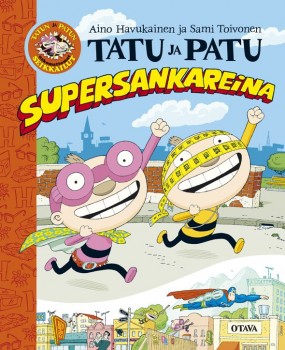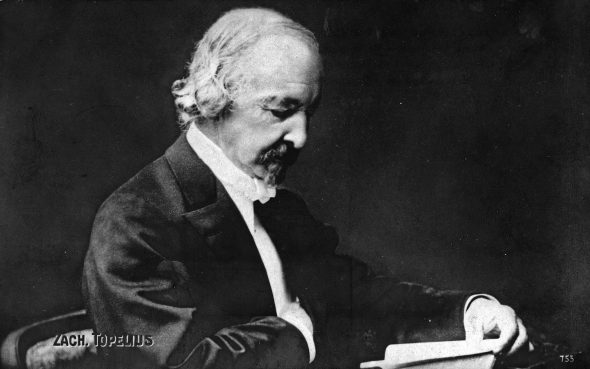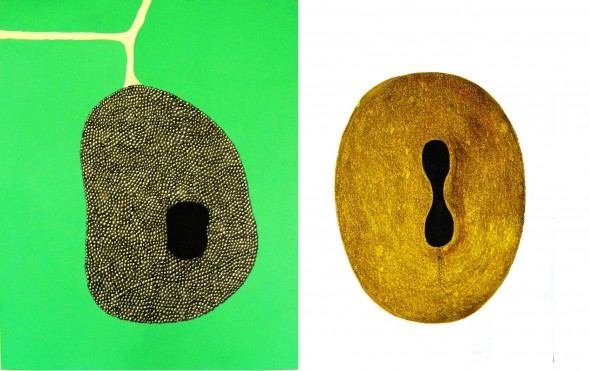Search results for "2010/05/2011/04/matti-suurpaa-parnasso-1951–2011-parnasso-1951–2011"
The magic box: childhood revisited
25 December 2014 | Essays, Non-fiction
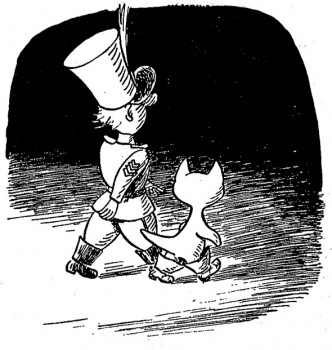
The tin soldier and the Blue Cat. Illustration: Usko Laukkanen
A tribute to Oiva Paloheimo’s children’s novel Tinaseppä ja seitsemän (‘The Tinsmith and the Seven’, illustrated by Usko Laukkanen, WSOY, 1956)
I’ve happened upon this (Christmassy) text of mine – first published in Books from Finland back in 1995 – when sorting through my papers as I begin to contemplate my retirement. With it I would like to offer my goodbyes, and many thanks, to you – to our readers, for whom I have been commissioning, editing and writing texts for the past thirty-one years – it’s time to do other things; time to read the books that still remain unread…
A dusky winter’s afternoon. Outside, soft and grey, a little snow is falling. I am sitting in our living-room, in an armchair covered in a pale yellow boucle fabric, my legs curled up, eating a carrot. In my lap is a book which I have fetched from the library after school. Conversation, the faint clattering of crockery, a singing kettle, the smell of food: grandmother and mother are cooking supper in the kitchen. My little sister is asleep.
But these sounds and the room around me do not really exist: there is only the world of make-believe in which Tiina sets off on her adventures with the Blue Cat, the Tinsmith, the St Bernard dog, the star and the spider: that world is a magic box which is able to contain all of childhood. More…
What Finland read in November
17 December 2010 | In the news
In November the latest thriller by Ilkka Remes, Shokkiaalto (‘Shock wave’, WSOY) topped the Booksellers’ Association of Finland’s list of the best-selling Finnish fiction. Sofi Oksanen’s prize-winning, much-translated 2008 novel Puhdistus (Purge, WSOY), has not left the best-selling list since it was awarded the Finlandia Prize for Fiction this autumn and was now number two.
Riikka Pulkkinen’s novel Totta (‘True’, Otava) was number three, and Tuomas Kyrö’s colllection of episodes from a grumpy old man’s life as told by himself, Mielensäpahoittaja (‘Taking offense’, WSOY), from last spring, occupied fourth place.
A new novel, Harjunpää ja rautahuone (‘Harjunpää and the iron room’, Otava), by the grand old man of Finnish crime, ex-policeman Matti Yrjänä Joensuu, was number five.
The most popular children’s book was a new picture book about two inventive and curious brothers, Tatu ja Patu supersankareina (‘Tatu and Patu as superheroes’, Otava) by Aino Havukainen and Sami Toivonen.
On the translated fiction list were books by, among others, Ildefonso Falcones, Jo Nesbø, Lee Child, Stephen King, Paulo Coelho and Paul Auster.
The non-fiction list included the traditional annual encyclopaedia Mitä missä milloin (‘What, where, when’, Otava, second place) as well as a political skit entitled Kuka mitä häh (‘Who what eh’, Otava) by Pekka Ervasti and Timo Haapala – the latter sold better, coming in at number one. In November the latest thriller by Ilkka Remes, Shokkiaalto (‘Shock wave’, WSOY) topped the Booksellers’ Association of Finland’s list of the best-selling Finnish fiction.
Mikko Lahtinen: Kirjastojen maa [Land of libraries]
4 March 2011 | Mini reviews, Reviews
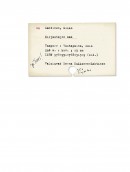 Kirjastojen maa
Kirjastojen maa
[Land of libraries]
Tampere: Vastapaino, 2010. 394 p., ill.
ISBN 978-951-768-315-9
€ 43, hardback
Libraries are the most widely used cultural service in Finland. Kirjastojen maa describes the journey undertaken by the protagonist, who refers to himself as ‘the Library Man’, and his entourage to 250 public libraries around Finland between 2008 and 2010. Many of these sites were celebrating their 150th anniversaries at the time, since there was a great enthusiasm for establishing public libraries in Finland in the 1850s. This travel journal provides a history of libraries as an institution and their development into a central pillar of society. The author also considers Finnish intellectual space in this age of digital media. Libraries currently face significant challenges: the recent wave of local authority mergers, centralisation of public services and funding cuts are all hampering the development of library operations. The importance of libraries is further underlined by the fact that local residents have launched protests in support of libraries threatened with closure – in spite of the usual difficulty of rousing Finns to man the barricades. The author is a philosopher, political researcher and active participant in public policy discussions.
Translated by Ruth Urbom
Solid, intangible
26 September 2013 | Fiction, poetry
Poems from Mot natten. Dikter 2010 (‘Towards the night. Poems 2010’, Schildts & Söderströms, 2013). Introduction by Michel Ekman
Memory
If you give me time
I don’t weigh it in my hand:
it’s so light, so transparent
and heavy as the thick
shining darkness
in the backyard gateway
to memory
Helsinki: World Design Capital 2012
13 January 2012 | This 'n' that
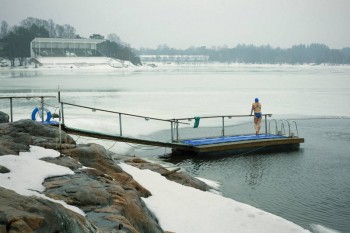
Swimming in the rain: winter joys of Helsinki. Photograph: Valtteri Hirvonen – Eriksson & Co.
After Turin (Italy, 2008) and Seoul (Republic of Korea, 2010), 2012 Helsinki is the third World Design Capital, selected in 2009 by the International Council of Societies of Industrial Design (ICSID).
Helsinki was considered to be a city where ‘design has for decades been a pivotal enabler to building an open city’.
The theme is ‘Open Helsinki – Embedding Design in Life‘. The idea is to improve the everyday life and environment of the citizens and the development of both public services and private enterprises.
In addition to Helsinki, the realisation of the Design Capital year will be carried out by four other cities: neighbouring Espoo, Vantaa and Kauniainen as well as Lahti (some hundred kilometres north of the capital). The Finnish government, two ministries, 21 commercial companies and some universities will co-operate in this project, which has a budget of 16 million euros (2010–2013).
The programme includes some 300 different events, half of them development projects, themed ‘The changing city’ or ‘New solutions’; the other half consists of various exhibitions and encounters for the citizens of Helsinki, tourists and design people.
The ultimate goal of this all is said to be ‘permanent change’. Whatever that really means – good luck!
However, as writer and design critic Kaj Kalin noted in a review in Helsingin Sanomat newspaper (30 December), Finland is full of well-educated designers, but lacks both investment money prepared to take risks and working industry: soon all production will have moved to cheaper countries – and nobody will be able to produce anything. New Finnish design, Kalin argues, mostly approximates merely to ‘a show parade of models and prototypes’.
Jorma & Päivi Tuomi-Nikula: Nikolai II: Suomen suuriruhtinas [Nicholas II: Grand Duke of Finland]
11 March 2011 | Mini reviews, Reviews
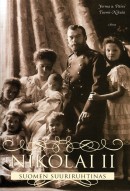 Nikolai II: Suomen suuriruhtinas
Nikolai II: Suomen suuriruhtinas
[Nicholas II: Grand Duke of Finland]
Jyväskylä: Atena, 2010. 283 p., ill.
ISBN 978-951-796-650-4
Swedish-language edition:
Nikolaj II: Storfurste av Finland
Helsingfors: Schildts, 2010
ISBN 9789515018714
€ 41, hardback
This work is the first Finnish biography of the last Grand Duke of Finland, Tsar Nicholas II (1868–1918). It provides a new approach to historical writing in its treatment of the Tsar’s relationship with Finland in the face of increasing terror, the First World War and the 1917 revolutions. Terrorism as a form of resistance during the period of oppression in 1904–07 was more widespread in Finland than previously thought. Extracts from diaries, letters and other documents provide the background to events on the global political stage as well as the private lives of the figures. Finns initially responded favourably to Nicholas’ ascent to the throne in 1894, but this trust soon declined with Nicholas’ policy of Russification. Despite these increasingly strained relations, Nicholas enjoyed spending his holidays in Finland. This book contains a wealth of photographs, including some from the personal albums of Anna Vyrubova, a lady-in-waiting who fled to Finland. There are also never-before-published postcards dating from the era of oppression and revolution. The authors have previously written about the Tsars in Finland’s era as a Grand Duchy of Russia in their book Keisarit kesälomalla Suomessa (‘The emperors on summer holiday in Finland’, 2002).
Translated by Ruth Urbom
Green thoughts
Extracts from the novel Kuperat ja koverat (‘Convex and concave’, Otava, 2010)
I decided to go to the Museum of Fine Arts.
After paying for my entrance ticket, I climbed the wide staircase to the first floor. There all I saw were dull paintings, the same heroic seed-sowers and floor-sanders as everywhere else. Why were so many art museums nothing more than collections of frames? Always national heroes making their horses dance, mud-coloured grumblers and overblown historical scenes. There was not a single museum in which a grandfather would not be sitting on a wobbly stool peering over his broken spectacles, interrogating a young man about to set off on his travels, cheeks burning with enthusiasm, behind them the entire village, complete with ear trumpets and balls of wool. The painting’s eternal title would be ‘Interrogation’ and it would be covered with shiny varnish, so that in the end all you would be able to see would be your own face.
I climbed up to the next floor. All I really felt was a pressing need to run away. No Flemish conversation piece acquired in the Habsburg era was able to erase a growing anxiety related to love. More…
Vesa Sirén: Suomalaiset kapellimestarit. Sibeliuksesta Saloseen, Kajanuksesta Franckiin [Finnish conductors. From Sibelius to Salonen and from Kajanus to Franck]
17 February 2011 | Mini reviews, Reviews
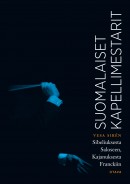 Suomalaiset kapellimestarit. Sibeliuksesta Saloseen, Kajanuksesta Franckiin
Suomalaiset kapellimestarit. Sibeliuksesta Saloseen, Kajanuksesta Franckiin
[Finnish conductors. From Sibelius to Salonen and from Kajanus to Franck]
Helsinki: Otava, 2010. 1,000 p., ill.
ISBN 978-951-1-21203-1
€ 38, hardback
This work, by music critic Vesa Sirén – awarded the Finlandia Prize for non-fiction in 2010 – attempts to explain what makes a good orchestra conductor. Including hundreds of interviews, the book takes a chronological approach, presenting portraits of sixty conductors from the 1880s up to current students of conducting. There are also contributions from music critics, as well as even tougher assessments from musicians, contemporaries of the conductors. The high standard of Finnish music education, which has been easily accessible to young people – at least until the recent times –, provides part of the answer, as does the conducting course at the Sibelius Academy under the long-serving leadership of Jorma Panula. Sirén’s archival research has unearthed some forgotten treasures, including the lost archives of Robert Kajanus and conductor’s notes in Jean Sibelius’ own handwriting.
Translated by Ruth Urbom
Candidates for the Runeberg Prize
23 December 2009 | In the news
Seven books were chosen out of approximately 200 to be the candidates of the Runeberg Prize, to be awarded on 5 February 2010. More…
Markus Nummi: Karkkipäivä [Candy day]
26 November 2010 | Mini reviews, Reviews
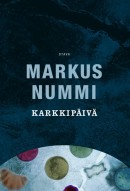 Karkkipäivä
Karkkipäivä
[Candy day]
Helsinki: Otava, 2010. 383 p.
ISBN 978-951-1-24574-2
€28, hardback
Like this one, Markus Nummi’s previous novel, Kiinalainen puutarha (‘Chinese garden’, 2004), set in Asia at the turn of the 20th century, involves a child’s perspective. Karkkipäivä‘s main theme, however, is a portrait of contemporary Finland. Tomi is a little boy whose alcoholic parents are incapable of looking after him; Mirja’s mother is a frantic workaholic heading for a nervous breakdown. She is a control freak who secretly gorges on chocolate at work and beats her little daughter – a grotesque portrait of contemporary womanhood. Tomi manages to get some adult attention and help from a writer; the relation between them gradually builds into one of trust. Katri is a social worker, empathetic but virtually helpless as part of the social services bureaucracy. Virtually every adult suspects others of lying, finding each other’s motives doubtful. Nummi (born 1959) has structured Karkkipäivä with great skill; the ending, in which matters are resolved almost by chance, is particularly gripping. This novel was nominated for the 2010 Finlandia Prize for Fiction.
Teemu Keskisarja: Vihreän kullan kirous. G.A. Serlachiuksen elämä ja afäärit [The curse of green gold. The life and affairs of G.A. Serlachius]
17 March 2011 | Mini reviews, Reviews
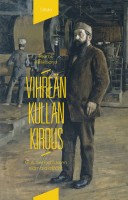 Vihreän kullan kirous. G.A. Serlachiuksen elämä ja afäärit
Vihreän kullan kirous. G.A. Serlachiuksen elämä ja afäärit
[The curse of green gold. The life and affairs of G.A. Serlachius]
Helsinki: Kustannusosakeyhtiö Siltala, 2010. 350 p., ill.
ISBN 978-952-234-041-2
€ 35, hardback
In the famine years of the 1860s and with no inherited fortune to his name, G.A. Serlachius (1830–1901) built his industrial centre in the rural backwoods of Mänttä. His work laid the foundations for what would become one of Europe’s leading paper manufacturers. G.A. Serlachius was a Finnish self-made man whose education was cut short due to his family’s financial difficulties. The energetic Serlachius is considered to have pioneered contacts with Western European markets; he was responsible for bringing the first icebreaker ship to Finland. Serlachius was also known as a patron of the arts and a supporter of artists; the collection of the Serlachius Art Foundation is his best-known legacy. According to this biography, Serlachius suffered from ‘an extremely advanced megalomania’ in the opinion of his bankers, and his personality was ‘more aggressive than many Finnish-born generals of the Pax Russica’. The Association of the Friends of History selected this book as its History Book of the Year for 2010.
Translated by Ruth Urbom
Markku Koski: ‘Hohto on mennyt herrana olemisesta’ [‘The glory has gone from being a VIP’]
7 May 2010 | Mini reviews, Reviews
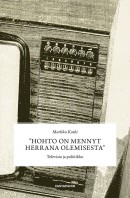 ‘Hohto on mennyt herrana olemisesta’ – Televisio ja poliitikko
‘Hohto on mennyt herrana olemisesta’ – Televisio ja poliitikko
[‘The glory has gone from being a VIP’ – the television and the politician]
Tampere: Vastapaino, 2010. 254 p.
ISBN 978-951-768-249-7
€ 29, paperback
This book, based on the author’s doctoral thesis in Media and Communication Studies at the University of Tampere, presented in February 2010, takes as its starting point Walter Benjamin’s well-known essay, ‘The Work of Art in the Age of Mechanical Reproduction’. Koski applies Benjamin’s ideas on cinema and film stars to contemporary television and politics. Koski maintains that while the public have become alienated from politics, politicians have also become alienated from themselves and have become reiterative entities whose essential content is repetition. After television and other new media have called into question traditional forms of politics, a significant challenge for politicians has been to prevent viewers from getting bored. Koski discusses relationship between politics and comedy, the ‘cynical’ viewer, the popular public image of Marshal Mannerheim (an iconic figure in Finnish history and politics) and the popularity of Sauli Niinistö, the frontrunner in the upcoming (2012) Finnish presidential election. Dr Koski also considers historical and contemporary image politicians in various other countries.
Riikka Pulkkinen: Totta [True]
22 October 2010 | Mini reviews, Reviews
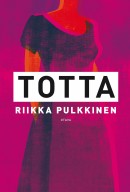 Totta
Totta
[True]
Helsinki: Otava, 2010. 333 p.
ISBN 978-951-1-22965-0
€ 31,40, hardback
The second novel by Riikka Pulkkinen (born 1980) is a comprehensive work that tackles big themes: love, death and rejection. Pulkkinen’s particular strengths as an author are her richly nuanced language and her mastery of structure. While the ending provides food for thought, the book is an enjoyable novel about childhood, growing up, daring to love and live. Martti, a seventy-year-old artist, is caring for his sick wife, a highly respected psychologist. Martti and Elsa have had a long and happy marriage. Then it emerges that Martti had a long affair with their live-in childminder Eeva, whose story grows into one of the main plot strands of the book. Their love story takes place against the background of the 1960s, when the waves passing through European society reached Finland as well. Pulkkinen skilfully brings the perspective of the now grown-up daughter Eleonoora into the mix, as she views her early childhood under the care of two mother figures. At the 2010 Frankfurt Book Fair translation rights to Totta were sold to six countries, which at least goes to show that there is interesting literature to be found in the Nordic countries beyond the ubiquitous crime novels.
Georg August Wallin: Skrifter. Band 1 [Writings. Volume 1]
2 December 2010 | Mini reviews, Reviews
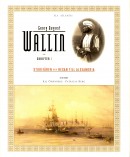 Skrifter. Band 1: Studieåren och resan till Alexandria
Skrifter. Band 1: Studieåren och resan till Alexandria
[Writings. Vol. 1: Studies and the journey to Alexandria]
Utg. [Edited by] av Kaj Öhrnberg & Patricia Berg & Kira Pihlflyckt
Helsinki: Svenska litteratursällskapet i Finland, 2010. 455 p., ill.
ISBN 978-951-583-189-7
ISBN 978-91-7353-371-3 (Bokförlaget Atlantis, Stockholm, 2010)
€ 43, hardback
This is the first volume of a planned six-volume critical edition of the writings of Finnish Arabic scholar Georg August Wallin (1811–1852). The main material for the first volume consists of full text of Wallin’s travel diaries and letters from the years 1831–1843. The Arabic texts are accompanied by parallel Swedish translations. The preface contains an overview of the phases of Wallin’s life and the schools of Orientalism and Rousseau which influenced his work. Wallin’s seven-year research journey to the Middle East, and particularly his crossing of the northern Arabian peninsula as the first Western researcher to do so, brought Wallin great international acclaim. Wallin was the first researcher to record the poetry and study the dialects of the desert Bedouin. He is particularly well known for his visits to the holy cities of Mecca and Medina, forbidden to non-Muslims, and to the women’s quarters in their harems.

